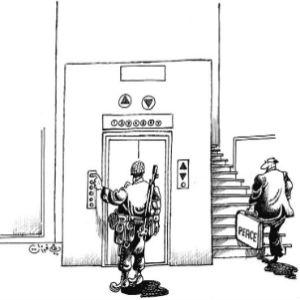After artist Ali Farzat was attacked for lampooning Syrian President Bashar al-Assad with cartoon and caricature portrayals, the artist’s popularity has sky-rocketed, emerging as a symbolic figure-head and providing artistic ammunition for the protesters of Syria.
Farzat’s work is renowned for the satirical edge of ridicule it holds against the corruption of politicians and authority. However, the artist has never publicly acknowledged the individuals and precise identification of those subjects in his work, until now. With the Syrian uprising of 2011, and the population’s continuing struggle, Farzat has identified the crucial figure of the country’s President Bashar al-Assad, within his work.
“I made that shift from using symbols to portraying actual figures, and little by little I began to see my cartoons being carried by protesters. They became a symbol for them” says Farzat.
The images of which Farzat speaks include a cartoon in which President al-Assad rips away at a calendar, knowing that the next day will bring more riots and protests within Syria. A second image portrays the President escaping in a getaway car with Libyan dictator Muammar Gaddafi for company. A third features the President unable to sit in a chair because the springs have been broken.
“Even the chair won’t accept him anymore,” Farzat explains.
The initial unveiling of these publicly humiliating cartoons brought with it threatening messages and attacks. One such event occurred on August 25th as the artist left his studio in Damascus. Three men attacked Farzat, beating him with batons and continuing the assault as they transported him in a car and finally dumped him by the side of the road for dead.
“I could hear them saying ‘break his hands so they never dare challenge his masters again.’ They hit me and hit me, on my head, on one hand and then the other and were trying to make sure they broke them. I had concussion and bruises over the whole of my body.”
A passing stranger took Farzat to hospital where he recovered but says that “my hands were broken so badly that movement is still limited.”
The attack became publicised news in Syria, where the population reacted in outrage.
Farzat recently served as a panel member for a discussion titled “Culture Under Fire” at the Reel Syria festival in the UK. The panel aimed to discuss the nature and role of art in times of conflict. In January, Farzat attached his name to an open letter with 49 other artists, the content of which described mutilations, murders, and called upon the regime to cease violence against the country’s population.
Farzat now resides in Kuwait where he has residency. “The real measure is not time, the real measure is that we have managed to break the barrier of fear. At that point the revolution became victorious. The question is always ‘when will it end?’ I don’t know, but it has already triumphed,” he said.





